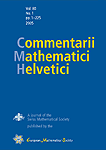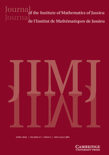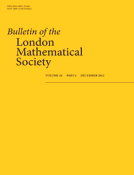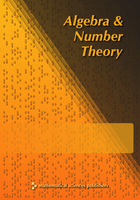
Journal of the Ramanujan Mathematical Society
Scope & Guideline
Unveiling New Horizons in Mathematical Science
Introduction
Aims and Scopes
- Number Theory:
The journal frequently publishes papers that delve into the intricacies of number theory, including topics such as partition functions, L-functions, and congruences. - Algebraic Geometry:
Many articles explore algebraic structures and geometric properties, including the study of varieties, ideals, and representation theory. - Graph Theory and Combinatorics:
Research on graph properties, combinatorial structures, and their applications is a significant focus, showcasing the interplay between algebra and discrete mathematics. - Representation Theory:
The journal includes work on the representation theory of groups, particularly in relation to modular forms and automorphic representations. - Mathematical Analysis:
Papers in this area investigate analytical methods and their applications across various mathematical contexts, contributing to the field's foundational theories. - Dynamical Systems and Number Theory:
The journal also features research on dynamical systems, particularly those connected to number-theoretical constructs and their implications.
Trending and Emerging
- Modular Forms and Their Applications:
Recent publications highlight a growing interest in modular forms, particularly their properties and applications to number theory and algebraic geometry. - Algebraic Structures in Modern Mathematics:
There is an increasing trend in exploring complex algebraic structures, including those related to nilpotent groups and algebraic groups, showcasing a deeper engagement with abstract algebra. - Computational Techniques in Mathematics:
The application of computational methods and algorithms in mathematical research is becoming more prominent, reflecting the need for practical techniques in solving complex problems. - Interdisciplinary Approaches:
Emerging themes often bridge various mathematical disciplines, indicating a trend towards interdisciplinary research that integrates concepts from different areas, such as algebra, geometry, and number theory. - Higher-Dimensional Algebra and Geometry:
There is a noticeable increase in research focusing on higher-dimensional spaces and their algebraic properties, which aligns with contemporary mathematical explorations.
Declining or Waning
- Classical Geometry:
Papers focusing on classical geometric concepts and properties have become less frequent, as the journal's emphasis shifts towards modern algebraic and combinatorial approaches. - Elementary Number Theory:
While still significant, traditional topics in elementary number theory, such as basic divisibility and prime distribution, appear to be receiving less attention in favor of more advanced topics. - Real Analysis:
Research specifically centered on real analysis has diminished, possibly as mathematicians explore more abstract or higher-dimensional analytical frameworks. - Historical Mathematical Studies:
Studies focusing on the historical aspects of mathematics and its development are increasingly rare, indicating a trend toward contemporary mathematical research.
Similar Journals

Periodica Mathematica Hungarica
Fostering Excellence in Mathematical Research and Applications.Periodica Mathematica Hungarica is a prestigious academic journal published by Springer, focusing on the field of mathematics, with a particular emphasis on miscellaneous mathematical studies. Established in 1971, this journal has maintained its commitment to advancing mathematical research and its applications, making significant contributions over its converged years through 2024. With a Q2 ranking in the mathematics category as of 2023, it establishes itself as a vital resource within the mathematical community. Researchers and academics will find its inclusion in the Scopus database, ranking #189 out of 399 in general mathematics, indicative of its impact and relevance. Although it does not feature open access, the journal provides a wealth of high-quality peer-reviewed articles, thereby serving as an essential platform for the dissemination of innovative mathematical theories, methodologies, and findings. Engaging with the content of Periodica Mathematica Hungarica is crucial for anyone looking to stay at the forefront of mathematical research and development.

ARS Mathematica Contemporanea
Advancing the Frontiers of Mathematical KnowledgeARS Mathematica Contemporanea, published by UP FAMNIT in Slovenia, stands as a pivotal journal within the fields of algebra, number theory, discrete mathematics, geometric topology, and theoretical computer science. Since its inception in 2011, this journal has consistently provided a rich platform for innovative research, garnering a commendable Q2 category ranking in various mathematical domains, including Algebra and Number Theory, and Geometry and Topology, showcasing its growing influence and prestige in the academic community. With an increasing Scopus rank—particularly notable in Algebra and Number Theory at the 71st percentile—ARS Mathematica Contemporanea is dedicated to publishing high-quality, peer-reviewed content that advances the frontiers of mathematical knowledge. The journal’s commitment to open access ensures that valuable research is readily available to scholars, practitioners, and students alike, fostering collaboration and dissemination of ideas across the globe. As it converges towards its dedicated timeline extending to 2024, ARS Mathematica Contemporanea remains a crucial resource for those engaged in mathematical research, presenting an array of theoretical and practical insights that define contemporary mathematical discourse.

COMMENTARII MATHEMATICI HELVETICI
Fostering Global Collaboration in Mathematical ExplorationCOMMENTARII MATHEMATICI HELVETICI, published by the EUROPEAN MATHEMATICAL SOCIETY, is a premier open-access journal in the field of mathematics, specifically categorized within the Q1 quartile of miscellaneous mathematics as of 2023. With an ISSN of 0010-2571 and an E-ISSN of 1420-8946, this esteemed journal has a rich history, having commenced its publication journey in 1929 and set to continue until at least 2024. Based in Germany, it provides a valuable platform for original research and significant advancement in mathematical theory and application, appealing to researchers, professionals, and students alike. The journal's commitment to open access since 2022 further enhances its accessibility and outreach, ensuring that cutting-edge mathematical developments are readily available to a global audience. Its Scopus ranking, which places it at the 165th position out of 399 in the general mathematics category (58th percentile), exemplifies its impact and relevance in the academic community.

BULLETIN DE LA SOCIETE MATHEMATIQUE DE FRANCE
Exploring the depths of mathematical inquiry.Welcome to the BULLETIN DE LA SOCIETE MATHEMATIQUE DE FRANCE, a distinguished journal published by the French Mathematical Society, dedicated to advancing the field of mathematics. With an ISSN of 0037-9484 and an E-ISSN of 2102-622X, this journal has made significant contributions to mathematical research since its establishment, maintaining a Q1 categorization in the Mathematics (miscellaneous) field as of 2023. Covering a range of mathematical topics, it serves as a vital platform for novel research findings and theoretical advancements. Although currently not open access, the BULLETIN remains accessible to a worldwide audience of researchers, professionals, and students eager to delve into the intricacies of mathematical inquiry. Situated in Marseille, France, it aims to foster collaboration and dissemination of knowledge, ensuring that high-quality research reaches its intended audience. Join a community that values the exploration and discourse around mathematics, and stay informed about the latest developments in this ever-evolving discipline.

Cambridge Journal of Mathematics
Unveiling the Depths of Mathematical KnowledgeCambridge Journal of Mathematics, published by INT PRESS BOSTON, INC, is a premier platform for the dissemination of cutting-edge research in the field of mathematics. With an ISSN of 2168-0930 and E-ISSN 2168-0949, this journal stands out in a competitive academic landscape, currently ranked #58 out of 399 in General Mathematics, placing it in the top 15% within its category according to Scopus metrics. The journal serves as a vital resource for researchers, professionals, and students alike, aiming to foster groundbreaking mathematical inquiries and foster collaboration across disciplines. Published from 2020 to 2024, the Cambridge Journal of Mathematics is committed to maintaining high standards of scholarship, making it an essential read for those who are passionate about advancing mathematical knowledge and its applications.

Analele Stiintifice ale Universitatii Ovidius Constanta-Seria Matematica
Advancing Mathematical Frontiers with Open Access InsightAnalele Stiintifice ale Universitatii Ovidius Constanta-Seria Matematica is a prominent open-access journal established by OVIDIUS UNIV PRESS in Romania, dedicated to advancing the fields of mathematics, specifically in Analysis and Applied Mathematics. Since its inception, the journal has emphasized the dissemination of high-quality research, making it accessible to a global audience. With an ISSN of 1224-1784 and E-ISSN 1844-0835, it has positioned itself within the academic community, achieving a respectable Q3 ranking in both analysis and applied mathematics in 2023, reflecting its commitment to rigorous scholarship. The journal spans a considerable publication window from 2009 to 2024, catering to the ongoing developments in mathematical sciences and their applications. Researchers, professionals, and students alike will find valuable insights and contributions that enrich their understanding and foster collaboration within the mathematical community. The journal's headquarters is based at the Faculty of Mathematics & Computer Science, Bulevardul Mamaia 124, Constanta, Romania.

Journal of the Institute of Mathematics of Jussieu
Uniting Global Minds in the Pursuit of Mathematical ExcellenceJournal of the Institute of Mathematics of Jussieu, published by Cambridge University Press, is a leading academic journal that has established itself as a vital resource in the field of mathematics. With an impressive impact factor and a ranking in the top quartile (Q1) of miscellaneous mathematics, the journal serves as a platform for high-quality research from both established scholars and emerging researchers. Spanning from 2002 to 2024, the journal aims to foster collaboration and innovation in the mathematical community by publishing original research articles, reviews, and critical discussions on a wide range of mathematical topics. Although the journal does not offer open access, it remains widely accessible through various academic institutions and libraries, ensuring that critical advancements in mathematics are shared with a global audience. Located in the United Kingdom at the prestigious Cambridge campus, the journal reflects the rigorous standards of its publisher and the rich academic tradition of its home institution.

Aequationes Mathematicae
Unveiling New Perspectives in Applied and Discrete Mathematics.Aequationes Mathematicae is a distinguished academic journal published by SPRINGER BASEL AG, focusing on the dynamic fields of Applied Mathematics, Discrete Mathematics, and Combinatorics. Since its inception in 1968, the journal has served as a vital platform for disseminating high-quality research, with Converged Years expected to extend to 2024. With an impressive Q2 ranking in multiple mathematical disciplines as of 2023, Aequationes Mathematicae is positioned within the top half of its field, reflecting its reputation for excellence. Spanning the globe from its base in Basel, Switzerland, this journal is ideal for researchers, professionals, and students seeking to advance their knowledge and contribute to ongoing discussions within mathematics. While it does not currently offer Open Access options, readers can still access an extensive archive of impactful studies that bolster its standing within the academic community.

BULLETIN OF THE LONDON MATHEMATICAL SOCIETY
Advancing Mathematical Frontiers Since 1969The BULLETIN OF THE LONDON MATHEMATICAL SOCIETY, published by Wiley, is a distinguished journal that serves as a vital resource in the field of mathematics. With its ISSN 0024-6093 and E-ISSN 1469-2120, this journal has consistently provided a platform for innovative research and scholarly discourse since its inception in 1969. Recognized for its quality, it currently holds an impressive Q1 ranking in the mathematics category, a testament to its significance in disseminating influential findings and trends in the mathematical sciences. Researchers and practitioners can rely on the BULLETIN for its comprehensive coverage of both theoretical and applied mathematics, which caters to a diverse audience ranging from professionals to students alike. Though it does not currently offer Open Access options, its articles can be accessed through institutional subscriptions, ensuring that significant works reach the academic community effectively. With contributions that span over five decades, the journal continues to shape mathematical research and inspire future advancements in the discipline.

Algebra & Number Theory
Unveiling New Horizons in Mathematical ScienceAlgebra & Number Theory, published by Mathematical Science Publications, stands at the forefront of mathematical research, particularly in the fields of algebra and number theory. With an ISSN of 1937-0652 and E-ISSN 1944-7833, this esteemed journal provides a dedicated platform for the dissemination of cutting-edge theoretical advances and practical applications. It has achieved a Q1 category ranking in both algebra and number theory according to the 2023 quartiles, reinforcing its critical role in shaping contemporary mathematical discourse. The journal serves as an essential resource for researchers, professionals, and students alike, offering insights into diverse mathematical methodologies and fostering open dialogue among scholars. Although it does not provide open access, its robust impact factor reflects the high quality and relevance of its published work. Based in the United States at the University of California, Berkeley, the journal's commitment to excellence continues to attract contributions that push the boundaries of mathematical understanding.